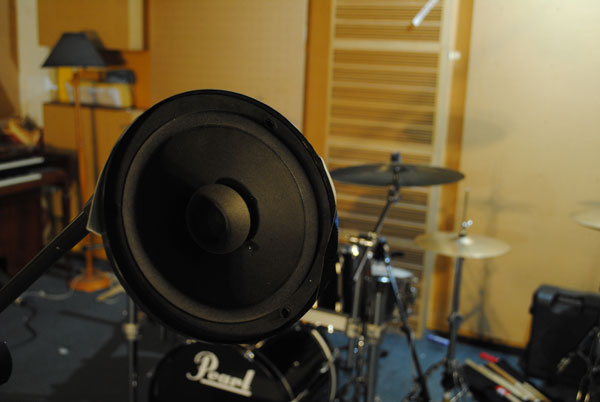Check out the video from the recording session here, or else read about it below. You can download a song from the session at the bottom of this page.
Several years ago I heard about recording engineers using speakers as microphones. One famous story goes that in the 1960’s, The Beatles were questioning the Abbey Road engineers as to why their records didn’t have as much bass as some American records at the time. This led to engineer Geoff Emerick to experiment with using a speaker as a microphone in front of the bass guitar amplifier speaker. An example of the result can be heard on the song Paperback Writer.
This prompted me to have a go at recording using a speaker as a microphone myself. I rewired and old 8” hi-fi speaker and was pleasantly surprised when it worked really well, not just on bass but also on a number of other instruments. It didn’t necessarily reproduce higher frequencies very well, but it had a nice round tone to it. This gave me the idea to push things even further, and record a whole band using only speakers as microphones.
But why stop at limiting the recording only in this manner? I decided to add some more limitations to have a bit of fun with the recording process, and challenge ourselves a bit. The rules that I set out were:
– Only speakers can be used as microphones;
– No DI’s;
– Maximum 8 channels (not including effects);
– No digital gear;
– No headphones for monitoring; and,
– All amps, drums etc in one room.
The Crew
We needed a band to record that was going to be up for these shenanigans, so I got my recently broken up band Teen Skank Parade back together in the studio to bash through a few songs one evening. The band’s thrash-punk-rock sensibilities suited the rough-and-ready live approach to the recording process.
Infidel Studios had all the appropriate analogue gear for the recording, including a 16 track 2 inch Otari tape machine, so I recruited Duncan Lowe and Cameron Burns from the studio to undertake the recording.
Transducers
Speakers and microphones are both transducers, which convert acoustic energy into electrical energy in the case of microphones, or vice versa in the case of speakers in their typical application. Dynamic microphones and speakers work on the same principle of a coil moving within a magnetic field, which means that they can be used interchangeably. In some small electronic devices, such as intercoms and walkie-talkies, the speaker and microphone are the same thing.
One thing to consider when using speakers as microphones is that the average speaker will have an impedance of 4 to 8 ohms, whereas the average microphone will have an impedance of 150 to 250 ohms. There are designs on the internet for circuits to better match the impedance between speakers and mic preamps, But as my first speaker mic worked so well without such a circuit, and taking the aesthetic o the band into account , we went for the simple option of just connecting up an XLR and plugging straight in. The only real issue was that the signal was too hot for the mic preamps in a couple of cases, so they were plugged straight into a line input instead on the mixing console.
Speakers can have a fairly wide figure-of-eight polar response, depending on how it is mounted or housed, so this can be tricky if you are trying to minimize spill in a situation where all the instruments were in the same room, as was our case. Rather than attempt to minimize spill in our case, we just embraced it as part of the sound.

Headphones for Pseudo-binaural
Binaural recording is a stereo technique that involves using a dummy head with microphones placed where the ears are. The result is a realistic stereo field when listening back to the recording through headphones. One of the things we tried out was using a pair of headphones inside out on the drummer’s (that’s me) head as microphones. These were essentially the drum overheads for the recording.
Another interesting aspect of this approach was that the overheads would be moving as the drummer moved which might result in a shifting stereo image. The headphones that were ultimately used were not a particularly good sounding pair, and the engineers didn’t particularly like the sound much, so not much of these channels were used in the final mix.
Effected
With no digital gear allowed, Duncan and Cam got creative and set up some analogue effects. The studio has an old spring reverb unit and in addition, they decided to try a couple of other options.
A tape delay was set up using a Studer A810 quarter inch tape machine. The length of the delay is defined by the distance between the sync and repro heads as well as the tape speed. In this case a speed of 3.75 inches per second was used which resulted in a delay somewhere in the region of 360 to 380 ms. The tape delay was used on vocals and guitars, although due to the bleed from everything being in the same room, a lot of everything ended up on the tape delay.
A room reverb was also set up with a mix of sounds being sent from an Aux Send on the mixing console to the hi-fi stereo amplifier in the studio’s rec room. The rec room itself is a largish room with lots of brick, concrete and glass, which made for a quite bright and reverberant sound. The amplifier was cranked really loud to the point of hurting and a pair of headphones mounted on a microphone stand then captured the sound.
The Mix
When initially planning for the recording session, I only wanted a stereo mix straight to tape, with no multitrack recording. In the end we opted for multi-track recording because there wasn’t enough time to sufficiently control and refine the live mix. Instead, I only allowed them an hour to do the mixes and they had to stick to the rules of no digital gear. They mixed off the 2 inch tape multitrack onto quarter inch tape. The mix was ultimately transferred into digital for distribution and playback, although distributing cassette copies for play back along with a recommendation to use microphones as speakers was considered.
So how did it turn out? Better than I expected actually. I was thinking that things might get really distorted and nasty, which didn’t actually worry me, but the recording actually turned out quite well in my opinion considering the circumstances. The speakers certainly all had their own tone, and were not great for recording higher frequencies very well, but the result is a recording with some character that we are quite happy with.
DOWNLOAD MP3 of Cranial Charity by Teen Skank Parade
This version is the digital transfer from tape, normalised to a peak of -0.1dBFS, with no further processing.
